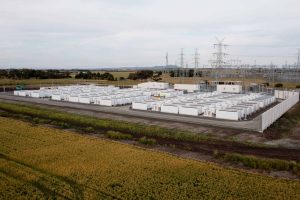FAQs
ABOUT THE BATTERY
The 300MW battery covers an area similar in size to football oval at Geelong’s GMHBA Stadium.

The Victorian Big Battery is located near the existing Moorabool Terminal Station, approximately 13km northwest of Geelong.
This land is ideal because it is flat and is next to the high voltage 500KV transmission line which means the power can be sent quickly to where it is needed.
The Victorian Big Battery supports the increasing number of solar and wind projects in Victoria.
We used Tesla Megapacks which have a 20 year lifespan. They retain most of their capacity right up to this point and are often capable of operating beyond this time depending on market conditions and other factors.
The Victorian Big Battery stores energy in times of high production and releases energy in times of high demand, similar to how a battery on a home solar system works. It also helps to stabilise the grid in a few different ways – it has an emergency response mode to prevent blackouts and it can maintain voltage and frequency levels.
ECONOMIC
The Victorian Big Battery can reduce costs for consumers in three ways:
- supporting more wind and solar, which are now the cheapest forms of power
- allowing more power to flow into the state, increasing competition and pushing electricity prices down
- helping to avoid blackouts and the associated costs
SIPS stands for Systems Integrity Protection Scheme.
A 250 MW SIPS service contract was awarded to the Victorian Big Battery by AEMO under the Victorian Government’s SIPS 2020 procurement process. Put simply, the scheme enables the additional import of electricity over the Victoria to New South Wales interconnector of up to 250 MW at peak times.
SIPS a mode of operation where the battery has a pre-programmed response to a network failure. When SIPS is triggered by an unforeseen power line failure or generator outage, the battery automatically charges or discharges to prevent a blackout.
Batteries are incredibly well suited to perform this service because they can respond at warp speed. Until recently, large power lines and state interconnectors had to maintain significant headroom to survive major interruptions. In recent years, SIPS from batteries have been used to unlock this capacity like opening up an extra lane on a freeway.
The Victorian Big Battery has created around 80 construction jobs and 6 full time ongoing jobs.
We sourced local suppliers where possible and our partner Ausnet sourced the power transformers from local business Wilsons Transformer Company.
LOCAL
Now that the battery is operational, there is minimal impact. The battery is visible at the site and looks like an enclosure of white containers.
We encourage the community to provide feedback through getting in contact via the contact us page.
We have established an annual Community Benefit Fund for the lifetime of the project, providing grants for local community-building and education initiatives.
SAFETY & ENVIRONMENT
The project required a development approval permit from the City of Greater Geelong Council.
The Victorian Big Battery meets all relevant standards for fire safety and we worked with the local CFA to ensure the project also meets their requirements.
Batteries, like all electrical equipment, require careful design to ensure that fire risk is mitigated and controlled. For the VBB the first line of defense for fire risk is to isolate any problem battery packs and prevent the problem spreading. The Tesla megapack battery modules are all individually controlled and require a system-OK signal to remain active. If the signal is lost for any reason, the individual battery packs self-isolate and disconnect from the power inverters. As a secondary line of defence, these battery packs are housed in separate IP rated insulated cabinets that are designed to contain any overheating issues to the affected cabinet only. The battery is also monitored 24hours a day, and we are able to diagnose issues through the control system. As a final line of defence the site has on-site fire-fighting water and equipment.
All of the medium voltage and high voltage cabling associated with the battery is underground, protected from extreme weather and external shorts. Perhaps the biggest fire risk is to the north and east of the battery site, where the existing above-ground high voltage power lines connect the Moorabool substation to customers in the electricity network. Here the battery contribution to fire risk is positive: the VBB has lightning conduction structures that help to reduce the risk of lightning strike on these existing transmission towers.
The battery uses similar technology to the batteries that are being increasingly installed in homes, just on a larger scale. There are no known health risks associated with properly maintained large-scale battery installations.
We commit to removing all above-ground infrastructure and the site will be rehabilitated when the project ceases to operate. This will be a condition of the Development Approval. After removal, a large percentage of the material in the batteries will be reclaimed or recycled; more than 60% of materials, especially critical minerals, will be recovered for re-use.